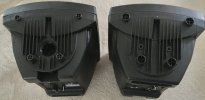Black Hole
May contain traces of nut
I have a pair of powered PA speakers (QTX as it happens), moulded plastic (as is common for such units). These have a socket for perching on a speaker stand with (IIRC) M6x1 clamp screws (I sourced some thumb screws for them).
They also have four cylindrical feet moulded in, and four sockets on the top so they will stack.
However, on the top surface they also have two M6 threaded holes, and I have no idea what those holes are for. Anybody enlighten me? I want to use them to fit a better carrying handle, but haven't got around to that yet (many years later...).
They also have four cylindrical feet moulded in, and four sockets on the top so they will stack.
However, on the top surface they also have two M6 threaded holes, and I have no idea what those holes are for. Anybody enlighten me? I want to use them to fit a better carrying handle, but haven't got around to that yet (many years later...).



